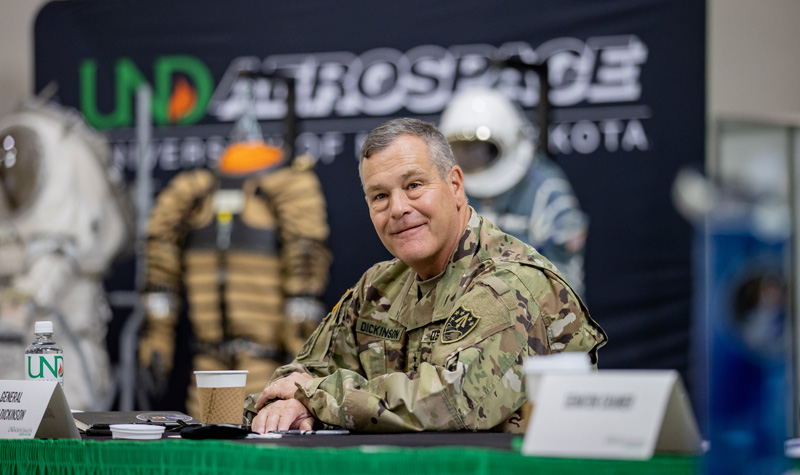Wake up and Fly Right (UND Today article featuring research collaboration)
Aviation and engineering researchers combine forces on patent-pending technology to make skies safer

UND Assistant Professor of Aviation Nick Wilson (left) and UND Assistant Professor of Electrical Engineering Kouhyar Tavakolian show off components of their patent-pending “Smartsealz” communication headset, which contain embedded technology that monitors aircraft operational signals and pilot brain activity for signs of mechanical problems and pilot mental fatigue. Photo by Tyler Ingham.
Call it a match made on the highways and byways of North Dakota. The result of it all, however, just might go a long way in making the world’s skyways a lot safer.
But none of it would have taken off were it not for a fortuitous pairing of two newly hired UND professors, from varied backgrounds, on a recent New Faculty and Administrators Bus Tour.
In the summer of 2014, Nick Wilson, an assistant professor of aviation, and Kouhyar Tavakolian, assistant professor of electrical engineering, were seatmates on the annual tour that takes University faculty and administrators new to the state on a three-day bus tour from Grand Forks to western North Dakota and back again. It’s designed to get the new employees better acquainted with the state and its people.
Wilson, a UND grad who had worked as an airline manager, pilot trainer and within aerospace business development, and Tavakolian, fresh from a post-doc stint at the University of British Columbia where he specialized in biomedical engineering advances, spent the trip getting better acquainted with each other and how they might combine their expertise into something bigger.
Well, Eureka!
The two, with the help of colleagues, students and private industry partner Rockwell Collins, are creeping toward aviation innovation gold with “Smartsealz,” a patent-pending cockpit integration technology designed to alert pilots to dangerous situations by gauging an aircraft’s spatial orientation or the pilot’s physiological state or both.
Skyway rumble strips
The innovative part derives from how the pilot is alerted, in this case, through signals and sensors working in parallel with an aircraft’s equipment, as well as in the pilot’s Smartsealz communication headset.
Sensors set within a plane’s control panel monitor deviations in altitude and navigation and send vibrating signals to the Smartsealz headset when necessary. Headset sensors are intended to monitor a pilot’s cardiac signals, and possibly in the future, brain waves for signs of fatigue or the onset of hypoxia, a serious condition brought on the by lack of oxygen to the brain that causes pilots to lose consciousness and eventually crash.
Through UND’s unique setup of having a world-class aviation education and research center in the John D. Odegard School of Aerospace Sciences and the Biomedical Engineering Research Complex at College of Engineering & Mines, Wilson and Tavakolian were able to develop a system that provides pilots with subtle but noticeable “haptic” feedback in the form of vibrations in the Smartsealz headset when a plane’s operation or pilot’s physiological state deviate from preset limits.
The researchers have described the alerts as a “highway rumble strip” embedded in the Smartsealz headset.
“We are quite ahead of the game when it comes to the navigation sensors on the plane because these are sensors that have no touch with the human body – you can get a very accurate signal recorded,” Tavakolian said. “But when it comes to cardiac signals from the head or brain signals from this little space (on the headset), that is where things get complicated.”
Wilson said the Smartsealz sensors could tap into either a plane’s flight-management system to monitor things such as altitude, desired course and other navigation metrics, or the physiological signals of the pilot for signs of fatigue and other problems. But the technology is stronger and more useful when the navigation and physiological signals are combined, reducing the chance for false-positive alerts.
“You don’t want to have a point where the headset becomes a chore or a distraction to wear, so you want to make sure that it is, in fact, the right amount of input,” Wilson said.
Tavakolian added, “if the two things accompany each other (a pilot’s heart rate is low and brain activity is at a lower frequency at the same time that the airplane is losing altitude) then that is something in which the pilot would be alerted.”
Tavakolian said the hope is that they will have a working prototype that monitors heart signals in 6-8 months.

Wilson, who has worked in many areas of aviation industry, operates a Virtual Avionics Procedures Trainer, donated to UND by Rockwell Collins for aviation training and research. Tavakolian (right), an expert in biomedical signal processing, looks on. The two men combined their unique areas of expertise to invent the Smartsealz technology. Photo by Tyler Ingham.
Serendipitous seating
Wilson said he became interested in looking for ways to mitigate aircraft mishaps that result from fatigue or other physiological abnormalities when he worked in curriculum development for regional airlines. He said, at the time, FAA rules and regulations on pilot fatigue and rest in commercial aviation operations had undergone substantial changes.
He brought that interest to his new role as an aviation professor at UND and eventually launched the collaboration with Tavakolian, an expert on biological signal processing.
The two started their combined research, in earnest, as part of the Alice T. Clark Program, which facilitates cross-campus collaborations. Still Wilson and Tavakolian maintain that it was the bus tour that served as the true impetus.
“We were seat neighbors on that tour. I just happened to see Nick as one of my first contacts at UND,” Tavakolian said. “We represent two strengths that exist here at this University.”
Expanded uses
Wilson and Tavakolian used $10,000 from the UND Office of Corporate Engagement & Commercialization as seed money to secure additional funding to continue research that led to the Smartsealz innovation. For example, they were awarded $100,000 in Venture grant funding from the North Dakota Department of Commerce, and from the private-sector, aerospace giant Rockwell Collins donated a Virtual Avionics Procedures Trainer, valued at more than $400,000 to UND to, among other things, assist in the Smartsealz project.
Wilson and Tavakolian have worked closely on the project with colleagues, such as Reza Fazel-Razai, co-director of UND’s Biomedical Engineering Program, and about 10 aerospace and engineering students over the past three years.
“When you are having these cross-disciplinary opportunities, there is a lot of value in it for the general consumer, for safety, and obviously, the University has benefited from this as well.”
Wilson said that the Smartsealz technology may have more uses beyond the traditional aviation industry. The innovation may one day find uses in UAS and air traffic control applications, various military scenarios and train operations, he said.
He added that the technology also may impact insurance rates and reduce safety costs related to the aviation and other fields.
“We look at this as simply an extra layer of safety blanket on top of existing technologies,” Wilson said. “We’re excited to keep pushing this forward, but as with anything, there’s always more work to do.”


